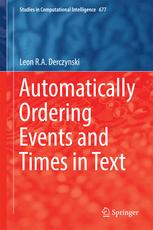

Most ebook files are in PDF format, so you can easily read them using various software such as Foxit Reader or directly on the Google Chrome browser.
Some ebook files are released by publishers in other formats such as .awz, .mobi, .epub, .fb2, etc. You may need to install specific software to read these formats on mobile/PC, such as Calibre.
Please read the tutorial at this link: https://ebookbell.com/faq
We offer FREE conversion to the popular formats you request; however, this may take some time. Therefore, right after payment, please email us, and we will try to provide the service as quickly as possible.
For some exceptional file formats or broken links (if any), please refrain from opening any disputes. Instead, email us first, and we will try to assist within a maximum of 6 hours.
EbookBell Team

4.4
22 reviewsThe book offers a detailed guide to temporal ordering, exploring open problems in the field and providing solutions and extensive analysis. It addresses the challenge of automatically ordering events and times in text. Aided by TimeML, it also describes and presents concepts relating to time in easy-to-compute terms. Working out the order that events and times happen has proven difficult for computers, since the language used to discuss time can be vague and complex. Mapping out these concepts for a computational system, which does not have its own inherent idea of time, is, unsurprisingly, tough. Solving this problem enables powerful systems that can plan, reason about events, and construct stories of their own accord, as well as understand the complex narratives that humans express and comprehend so naturally.
This book presents a theory and data-driven analysis of temporal ordering, leading to the identification of exactly what is difficult about the task. It then proposes and evaluates machine-learning solutions for the major difficulties.
It is a valuable resource for those working in machine learning for natural language processing as well as anyone studying time in language, or involved in annotating the structure of time in documents.